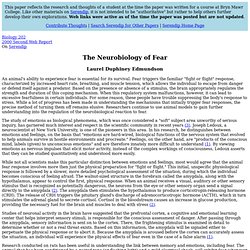

Overcoming the Fear of Making Mistakes. “Perfectionism is the voice of the oppressor, the enemy of the people.”

This is a famous quote from Anne Lamott in her book Bird by Bird: Some Instructions on Writing and Life. Intuitively, we know that perfectionism is unrealistic and restrictive, a tyrant that steals success. In fact, there are many sayings and experts that stress the importance of making mistakes for creating and achieving great things. But still there are many people who fear making mistakes. According to Martin Antony, Ph.D, professor of psychology at Ryerson University and co-author of When Perfect Isn’t Good Enough, “Generally, fears are influenced by both our biological and genetic makeup, as well as our experiences.”
We model what we see, Antony said. Emotional Reactions to the Economy: I'm Mad as HellAmerican Journal of Political Science, Vol. 30, No. 1 (Feb., 1986), pp. 50-78. Fear and anxiety: animal models and human cognitive psychophysiology. The aim of this paper is to explicate what is special about emotional information processing, emphasizing the neural foundations that underlie the experience and expression of fear.
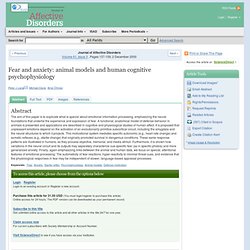
A functional, anatomical model of defense behavior in animals is presented and applications are described in cognitive and physiological studies of human affect. It is proposed that unpleasant emotions depend on the activation of an evolutionarily primitive subcortical circuit, including the amygdala and the neural structures to which it projects. This motivational system mediates specific autonomic (e.g., heart rate change) and somatic reflexes (e.g., startle change) that originally promoted survival in dangerous conditions. These same response patterns are illustrated in humans, as they process objective, memorial, and media stimuli. Toward an attribution therapy: The reduction of fear through induced cognitive-emotional misattribution. Toward an attribution therapy: The reduction of fear through induced cognitive-emotional misattribution.
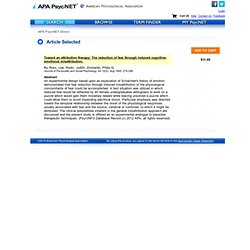
By Ross, Lee; Rodin, Judith; Zimbardo, Philip G. Journal of Personality and Social Psychology, Vol 12(4), Aug 1969, 279-288. Abstract An experimental design based upon an explication of Schachter's theory of emotion demonstrated that fear reduction through induced misattribution of the physiological concomitants of fear could be accomplished. A test situation was utilized in which reduced fear would be reflected by 40 female undergraduates willingness to work on a puzzle which would gain them monetary reward while leaving unsolved a puzzle which could allow them to avoid impending electrical shock.
Fears, phobias, and preparedness: Toward an evolved module of fear and fear learning. Josh Broman-Fulks - Department of Psychology. Attachment Theory and Close Relationships - Google Books. Risk perception. Early theories[edit] The study of risk perception arose out of the observation that experts and lay people often disagreed about how risky various technologies and natural hazards were.
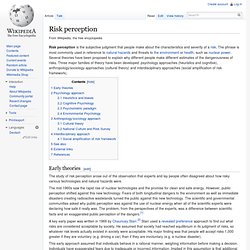
The mid 1960s saw the rapid rise of nuclear technologies and the promise for clean and safe energy. However, public perception shifted against this new technology. Fears of both longitudinal dangers to the environment as well as immediate disasters creating radioactive wastelands turned the public against this new technology. The scientific and governmental communities asked why public perception was against the use of nuclear energy when all of the scientific experts were declaring how safe it really was. A key early paper was written in 1969 by Chauncey Starr.[2] Starr used a revealed preference approach to find out what risks are considered acceptable by society.
This early approach assumed that individuals behave in a rational manner, weighing information before making a decision. See also[edit] Slovic, Paul, Baruch Fischhoff, Sarah Lichtenstein. “Why Study Risk Perception?” Risk Analysis 2(2) (1982): 83–93. Denial. Denial, in ordinary English usage, is asserting that a statement or allegation is not true.[1] The same word, and also abnegation, is used for a psychological defense mechanism postulated by Sigmund Freud, in which a person is faced with a fact that is too uncomfortable to accept and rejects it instead, insisting that it is not true despite what may be overwhelming evidence.[2][3] The subject may use: Many contemporary psychoanalysts treat denial as the first stage of a coping cycle.
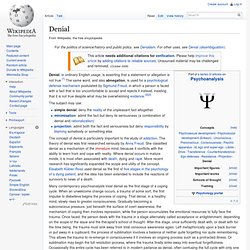
Climate change denial. This article is about campaigns to undermine public confidence in scientific opinion on climate change.
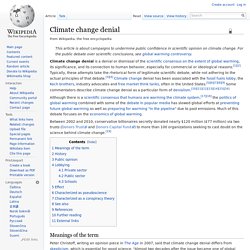
For the public debate over scientific conclusions, see global warming controversy. Climate change denial is a denial or dismissal of the scientific consensus on the extent of global warming, its significance, and its connection to human behavior, especially for commercial or ideological reasons.[1][2] Typically, these attempts take the rhetorical form of legitimate scientific debate, while not adhering to the actual principles of that debate.[3][4] Climate change denial has been associated with the fossil fuels lobby, the Koch brothers, industry advocates and free market think tanks, often in the United States.[5][6][7][8][9] Some commentators describe climate change denial as a particular form of denialism.[10][11][12][13][14][15][16]
Heartland – the beginning of the end for climate denial? Creating Fear" The process of creating fear takes place in the brain and is entirely unconscious.
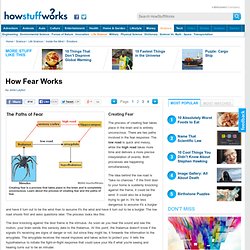
There are two paths involved in the fear response: The low road is quick and messy, while the high road takes more time and delivers a more precise interpretation of events. Both processes are happening simultaneously. The idea behind the low road is "take no chances. " If the front door to your home is suddenly knocking against the frame, it could be the wind. It could also be a burglar trying to get in. Fear. The Appalachian Online - The Psychology of Fear. The Neurobiology of Fear. Biology 202 2000 Second Web Report On Serendip Laurel Duphiney Edmundson An animal's ability to experience fear is essential for its survival.
